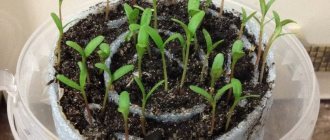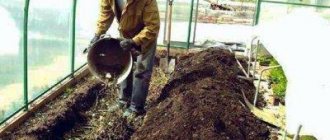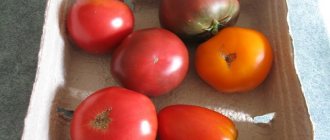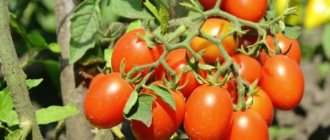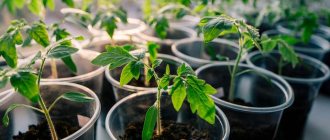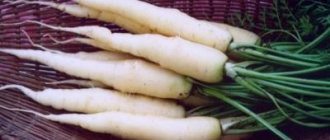Growing many agricultural plants requires preliminary preparation of seedlings. Boxes and pots with it take up a lot of space in the apartment, so gardeners are constantly looking for a solution to the problem of free space.
The method by which seedlings are grown in snails and diapers helps to avoid a large number of boxes and pots and not to occupy a large area with plants.
This method has been known for a long time, but gained popularity thanks to Yulia Minyaeva and her YouTube channel “In the garden or in the vegetable garden.”
How to properly plant tomatoes in a “snail”
Sowing vegetable crops in a “snail” involves 2 methods.
- seeds are germinated without using soil on toilet paper;
- sowing is carried out on a layer of soil 1-1.5 cm thick.
In any case, the gardener will need:
- plastic film (you can use used one) or disposable lunch bags,
- construction substrate,
- toilet paper,
- scissors or knife,
- Earth,
- seeds.
How to properly plant tomatoes in a “snail” without soil
It should be noted right away that when using this method, tomato seeds do not need to be pre-soaked or germinated.
These activities are replaced by the method of growing seedlings without land.
- You should prepare a strip of plastic film with a width equal to the width of the toilet paper sheet - this is the base.
- Place 2 layers of paper on top of it.
- We moisten from a spray bottle with a solution of the drug “Epin” or “Zircon”, “Energen”, “Chlorella Suspension”. You can use any other biogrowth stimulator.
Chlorella suspension is a natural biostimulant that accelerates root formation, increases resistance to stress, and a natural antibiotic completely destroys pathogenic microorganisms.
- Stepping back 1 cm from the top edge, we begin to lay out the tomato seeds, maintaining the same interval between the grains.
- The seeds cling well to a moistened match or toothpick and remain just as well on damp paper.
- Place another layer of paper on top of the seeds and lightly moisten them.
- Now carefully roll up the rolled-up cigarette, secure it with an elastic band or tape and place it in a glass with a small level (1-1.5 cm) of the same biostimulant.
- Be sure to write on the roll the type of tomato you sown.
The method of growing seedlings without soil is recommended to be used before the formation of cotyledon leaves.
For further development, the plant requires a large amount of nutrients, and paper simply does not have them. This method is also good for determining the percentage of seed germination.
Having a large supply of seed from his own plot, the gardener, without wasting time, effort and useful space, will select the strongest and healthiest sprouts from the seedlings. In addition, the seedlings are sterile and are never subject to the “black leg” disease.
How to properly plant tomatoes in a “snail” with soil
Those who do not risk transplanting seedlings at the cotyledon leaf stage can sow the seeds in the same “snails”, but with soil, and wait for tomato bushes with 2-3 leaves.
For this method, it is more advisable to use a laminate underlay. The “snail” holds its shape better and is more stable.
- First, we decide on the place of work and prepare a strip of base 10 cm wide. Knowing how many seeds you have, you can approximately calculate its length. But it is more convenient to work with a canvas of 80-100 cm.
- Having placed the substrate on a flat surface with the narrow side facing you, add soil and level it, slightly compacting it. The result should be a layer 1-1.5 cm thick. We wet the surface with a spray bottle and proceed to sowing.
- Using a match or your hands, spread the tomato seeds over the surface, departing 1 cm from the top edge. Leave the distance between the grains 1.5-2 cm.
- We roll up the “snail” without making much effort, otherwise the earth will be squeezed out.
- Pour soil onto the next section of the base and repeat the above steps.
When the “roll” stuffed with soil and seeds is ready, you need to secure it. Scotch tape, rubber bands, or any adhesive tape are suitable for this.
The “snail” is installed in a transparent container - it is easier to regulate the water level when watering. A plastic bag is placed on top - a greenhouse effect is created.
Now the entire structure should be placed in a warm place with t=25-28⁰C. This is the optimal temperature for tomato seed germination.
What other plants can be planted in “snails”
Pepper seedlings in a snail
The saving in useful space is immediately felt and gardeners who use this method for the first time have a desire to sow something else in the same way. Easily!
You can sow peppers, eggplants, cabbage, nigella onions, melons, watermelons, cucumbers, and all kinds of flowers in “snails”.
Only the sowing depth is adjustable. For small seeds, such as cabbage or nigella, the distance from the top edge is slightly reduced.
For very small seeds, such as petunia, first prepare a “snail” with soil, and only then sow on the surface of the soil.
How to dive into a diaper
We continue to save space on the windowsill and cut the grown seedlings into “diapers”. Again you will need a construction substrate or plastic film.
This material will serve as “diapers” for the sprouts.
- We are preparing a workplace where a low container with fertile and slightly moist soil should be located in close proximity.
- It is necessary to prepare a container in which improvised cups with seedlings will be installed. It is advisable to fill the bottom of the container with wet sawdust if you do not plan to bend the film to create a bottom.
- Always have a small watering can or spray bottle at hand.
- A spoon or small spatula will be needed to separate the sprouts from the substrate in the “snail”.
- Toilet paper will come in handy if you decide to make a cup with a bottom. During work, the earth will not crumble from below, but you can do without it.
- Rubber bands (adhesive tape) may be needed if the backing serves as a “diaper” - they are placed on the cup for fastening. If the sprout is transplanted into a roll of plastic film, then this is not necessary, they already hold up well.
Let's begin the process of swaddling tomato sprouts. It is more convenient to carry out work on a pallet with low sides. It is easier and easier to remove spilled soil from it.
- The base is placed on the pallet with the narrow side facing you. In the lower part, at 1/3 of the height, lay a strip of toilet paper equal to the length of the film - this is the bottom of the cup.
- Pour in a large spoon (or handful) of soil, 7-8 cm from the edge, and moisten it with a sprayer.
- The “snail” is unrolled and the desired sprout is selected. Remove from the substrate with a spatula and transfer to the “diaper”.
- Add another spoonful or two of earth on top. Toilet paper is folded up and sprayed so that you don't have to hold it.
- All that remains is to wrap the film to make a glass with a sprout inside.
If the soil from the upper part has crumbled, it is filled to the edges.
Cotyledon leaves should be 1-1.5 cm above ground level
Seedlings harvested in this way will have a separate feeding area and can be easily rotated around its axis for uniform illumination.
Picking tomatoes in diapers - video
Recipes for liquid fertilizers from Yulia Minyaeva
Anyone can make liquid fertilizers without significant costs. Fertilizers recommended by Yulia Minaeva:
- Nutrient liquid from grass clippings.
- Yeast feeding.
Every plot, regardless of its size, has to mow the grass several times a year. Instead of sending it to the compost, you can prepare a liquid for feeding tomatoes with your own hands. Add a glass of soda ash and directly cut grass to 200 liters of water. Cover the barrel with film and wait a week. Minaeva’s advice: use a diluted mixture for fertilizing in the proportion of 1 liter of fertilizer per 10 liters of water.
For the second recipe you will need dry yeast, they are inexpensive, and a good housewife always has a briquette at hand. A 100 g package is diluted in 10 liters of warm water. Be sure to add 2 tbsp. sugar and keep the fertilizer in the sun for 3 hours. The concentrate is ready. To avoid burning the roots, it is diluted in a ratio of 0.5 liters of fertilizer per 10 liters of water. Tomatoes are growing before our eyes, they are filling up, new ovaries are forming. The taste of the fruit is amazing: bright, rich.
Yulia is against chemical additives, but even without their use at the end of the season she boasts of huge tomatoes hanging in clusters from the bushes. To have a harvest every year like Yulia Minaeva’s, you don’t need to spend a lot of money on buying fertile land and fertilizing. You can make the necessary fertilizers yourself; the ingredients for them are inexpensive. It's nice to reap your own benefits, especially when there is a harvest of tomatoes grown without chemical additives on the table!
I suggest watching the video of the wonderful woman Yulia Minaeva. I always watch her videos with pleasure, there is something to learn. Moreover, Julia tells everything and explains it thoroughly. And all her video lessons look like thrillers. Pleasant voice, even somewhat bewitching
I advise everyone to pay attention to these videos. It is useful to look and get acquainted with new ways of planting absolutely all seeds
I myself planted all the seeds this way. So far I'm happy. They take up little space, although I planted a lot. Enjoy watching!
Growing in a "snail" without diving
But if desired, you can exclude the seedlings from diving into the “diapers”.
- To do this, when sowing tomato seeds in a “snail”, increase the distance between the seeds to 7-10 cm.
- After the seedlings have completed the formation of 2-3 true leaves and the nutrients are running out, the bundle is unrolled and fertile soil is added to the root system area.
- Then the bundle is returned to its original form and proper care is provided.
Timely watering, fertilizing with complex fertilizers once every 2 weeks and sufficient lighting will help grow strong seedlings without much expense.
The longest period for keeping sprouts in such conditions is one and a half months. After which the seedlings are planted in the greenhouse.
The advantage of this method is that the plant does not need time to adapt after transplantation. The entire growing period will be spent on developing the root system and increasing green mass.
Growing tomatoes in a snail without picking - video
Germinating seeds using film method with soil
There are several ways to “swaddle” seedlings. Some people grow plants in diapers with soil or coconut substrate, others without them at all. Some people pack only the seeds in film and then transplant them into cups with soil. And some recommend sprouting sprouts into diapers. In order for you to choose the most convenient method for yourself, we will consider all existing options.
Tip: With any method of using a diaper, you can use a trick. Write the name of the variety or its number on a strip of adhesive tape and stick it on the diaper film. You can also mark the film with a waterproof marker. In this case, wait until the inscription dries. This way you will observe the germination of different varieties, and you simply won’t get confused.
Let's start with germinating seedlings using the film method with soil, using cucumbers as an example.
Read also: Beekeeping for beginners where to start video
Caring for seedlings in “snails” and “diapers”
The “snail” with tomato crops is kept warm under a cover made of a plastic bag. At this time, they require daily ventilation and removal of condensation to avoid the appearance of mold on the soil surface. If necessary, spray the soil from a sprayer.
After the first shoots appear, the container with the “snail” is moved to a bright place. After mass shoots, the “snail” is freed from its shelter from the bag and regularly rotated around its axis if the sprouts bend in search of light.
Seedlings from early sowings need to be provided with additional lighting. Daylight hours for tomato seedlings should be at least 12 hours a day.
Water the seedlings in a container, making sure that there is no water in it constantly. A week before diving, fertilizing is carried out with complex fertilizers, but in a lower concentration.
After transplanting into “diapers”, the seedlings are shaded and not watered for several days (4-5). Further care for young tomato bushes consists of regular watering and providing the required amount of light. Once every 2 weeks, watering is combined with fertilizing with a full range of fertilizers.
Preparation
Wash the beets and grate them on a coarse grater or, to reduce labor costs, use a food processor. We will stew the prepared beets. A large, thick-bottomed stainless steel pan works well for this.
Ingredients and utensils
Place the grated beets in a saucepan. Add salt, sugar, vegetable oil, vinegar and water.
If your beets are very sweet, then you can put less sugar, in this case it is better to focus on your taste. The volume of water of 300 ml is also given approximately, since beets can be of different juiciness, but more on that below. No need to add any spices.
Mix all the ingredients thoroughly and place the pan on the stove. The beets are stewed over low heat for 2 hours after the start of boiling. You need to stir it regularly and make sure it doesn’t burn. If you see that there is not enough water for stewing, you need to add a little boiling water (100 - 200 ml).
There should be enough water for stewing. Place the finished beets in sterilized jars, compacting the mass a little with a spoon from time to time, so that there are no voids occupied by air. We seal the jars and turn them over.
You can see the whole process of preparing beets by watching the video. Its author is the famous blogger Yulia Minyaeva. Yulia also talks in detail about how she sterilizes jars in the oven and then uses them for preparations.
Georgian tomatoes are another delicious tomato appetizer. Salted tomatoes recipe: https://goo.gl/S5ytT2 Assorted.
Apples for the winter in a jar! | Apple Recipe In Season.
Soaked apples. My grandmother's recipe. Other recipes for winter preparations: Tender, crispy cabbage! https://www.y.
I cook them again and again! Flatbread in a Frying Pan With Potatoes. Giveaway from KITFORT.
THE GIVEAWAY IS CLOSED. How to make flatbreads is the topic of this video. Planetary mixer Kitfort KT-1308-2, white https://goo.
Awesome Apple Pie. Even a Child Can Cook!
Bulk pie with apples (apple pie). Subscribe to Channel 7DACH https://goo.gl/sqE5GL Website 7DACH https://7dach.ru/ If you are tired.
Advantages and disadvantages of the method
Each gardener has his own experience of growing tomatoes in “snails” and “diapers”. But there are general parameters that speak for and against this method.
Advantages
- The first and generally recognized advantage of the method of sowing in “snails” and “diapers” is the saving of space on the gardener’s first spring bed – the window sill.
- Soil saving. The soil is used only for the development of the root system.
- You can grow seedlings before planting in open ground. To do this, you need to sow the seeds at a distance of 7-10 cm from each other and periodically add soil to the root system.
- Significant budget savings. Purchased containers and mini-greenhouses for seedlings are much more expensive than a building substrate.
- Space saving. Bulk seedling boxes need to be stored somewhere, and small strips of substrate after washing are rolled into small rolls and put away in a secluded corner.
- When transplanting plants from a “snail” to a “diaper”, it is possible to interrupt the work at any time. The roots of neighboring sprouts are not damaged, since they do not touch each other. Add a handful of earth to the vacant space and roll it up. The “snail” will bide its time.
- There is no risk of intertwining of the root system and transmission of diseases through the soil.
- There is a real opportunity to increase the volume of soil in the “diaper”. To do this, simply unroll it and add the required amount of soil.
The disadvantages of the method include painstaking work, lack of skills and dexterity. But experience comes with practice, and gardeners have excellent patience.
Landing
Growing tomatoes in snails in a greenhouse from Yulia Mineeva is a rather difficult and labor-intensive task. However, if you understand the peculiarities of this process, you will be able to grow strong tomatoes for seedlings.
First, the working surface is covered with oilcloth so as not to stain it with soil. Then the substrate is prepared. To do this, use a knife to cut a small strip about 20 cm wide. It is laid on the work surface, after which a strip of toilet paper is placed on it. It is soaked with plain water or a growth stimulant so that the seedlings in the snails germinate faster.
We plant the seeds at a distance of 3-5 cm from the beginning of the snail. To do this, each seed is taken with tweezers and placed on the surface of the strip. Sow tomatoes at a distance of 2 cm from each other. After placing all the seeds, you can roll up the snail. This is done from the side where the seeds began to be laid out. Then the snail is placed in a small container and immediately covered with film. This is done to maintain optimal humidity levels and create a greenhouse effect.
After a few days, it is necessary to check the snail in the greenhouse, since already 2-3 days after planting, the first shoots may appear under the diaper. If most of the seeds have become germinated seedlings, then the snail will have to be placed on its side and unwound
This is done very carefully so as not to accidentally harm the young seedlings.
Before wrapping the snail again, the soil is fed. The fertilizer is spread on the surface in a small layer of several centimeters. It must be moistened in advance with a spray bottle and compacted thoroughly. The snail is then twisted again and secured with a rope or rubber band.
Common mistakes gardeners make
Despite all the positive qualities of the “snail” and “diaper” planting method, the seedlings can be ruined. And the reason for this is the gardeners themselves, who make some mistakes.
- Uncontrolled watering leads to excess moisture in the soil. The root system experiences oxygen starvation and often rots.
- Wrong choice of tomato variety. In a city apartment, it is better to grow determinate varieties. In tall varieties, with this method of cultivation, the formation of the flower cluster is disrupted and the stem bifurcates.
- You should not sow tomato seeds for seedlings before mid-March . Plants from early sowings are often elongated, have thin stems and pale green foliage.
Growing problems
Problems with growing seedlings at home are most often created by gardeners themselves. It happens that a seemingly healthy plant breaks and falls . This is a sure sign of damage to the so-called “black leg”. The reason may lie
- in increased soil acidity;
- in high soil moisture;
- dense planting;
- sudden change in temperature;
- in the use of contaminated soil and seed.
It is unlikely that it will be possible to save infected plants, but it is necessary to inspect the seedlings. Remove damaged plants and water the soil with a 1% manganese solution. It is easier to prevent a problem than to treat it, so constant monitoring of air temperature and soil moisture is recommended.
Yellowed leaves on tomato seedlings can also be the result of an imbalance in water balance. In this case, the reason may lie not only in overdrying of the soil, but also in waterlogging.
The next factor is a lack of microelements. If everything is in order with watering, it is recommended to apply a full range of mineral fertilizers. You can use the drugs “Emerald”, “Fertika Lux”, “Ferovit”.
Heavy soil in a seedling box dooms the root system of seedlings to oxygen starvation, and the result may be yellowed foliage.
You can often see elongated, thin and weak tomato bushes on windowsills. Most likely, the seeds were sown early and she did not have enough sunlight. Don't despair. Such seedlings must be planted in the ground with a significant penetration of the stem into the soil. The stem will give additional roots and the gardener will have a good harvest of tomatoes.
Reviews from gardeners about the method
Lubastik 12 January 22, 2022 17:45
Last year, due to a lack of space, some tomato seedlings were grown in diapers. I didn’t like the result: the plants looked dead and couldn’t be compared with those grown in boxes. Watering is difficult and inconvenient - it's a long stretch. It’s also difficult to add land. One advantage: they take up little space.
Soboleva March 10, 2022 Pervouralsk 16:50
I am very glad that I learned about this method of growing seedlings. The first experience turned out to be very successful. It seems that more has come up than she sowed. Eggplants, peppers, flowers are so thick-legged and handsome. I haven’t dived yet, but I will definitely do it in diapers.
Akshiri March 15, 2022 Ekaterinburg 14:46
This is the first year I’ve been planting snails, I tried it according to Yulia Minyaeva’s recommendations. Girls, beauty! My mother-in-law sowed the old fashioned way, and all the peppers died. Now she asks me to tell you about my method and is waiting for me to give her pepper seedlings.
Zanoza March 16, 2022 Sverdlovsk 12:38
Personally, I really liked sowing into snails. I sowed tomatoes in peat pots and snails at the same time. In the peat pots the sprouts have stretched out, and in the snail they are sitting strong.
Favorable landing days for 2020
In January (22, from 28 to 29) 2022, it is recommended to calibrate the seed material and prepare it for sowing.
February:
- in the first ten days (1–3, 6–7) - favorable days for preparing and germinating seeds;
- in the second and third ten days (19–20, 28–29) - days suitable for soaking and planting seeds.
March:
- first ten days (4–5) - planting of the main seed fund;
- second decade (13–14, 17–18) - optimal time for feeding and watering;
- third decade (27–28) - transplanting seedlings, picking.
The recommendations are based on the lunar calendar for gardeners.
